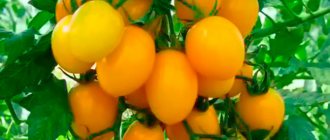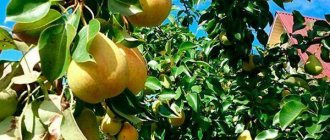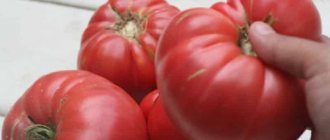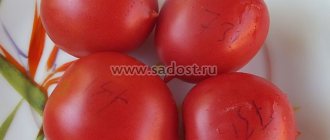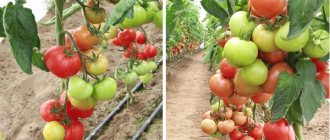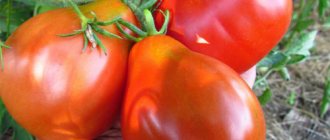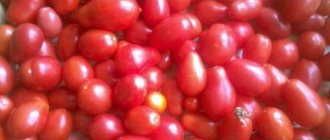| Ripening period: | early ripening |
| Shape, weight of fruits: | round, 20-25 grams |
| Bush type: | indeterminate |
| Growing regions: | southern, central |
| Productivity: | 7 kg per sq.m. |
The Magic Harp tomato is a godsend for gardeners in the central and southern parts of the country. This yellow-fruited cluster hybrid is famous not only for its good yield and quality of tomatoes, but also for its colorful appearance. The variety is heat-loving, created for cultivation in closed greenhouse structures. They are grown in open beds only in regions with a mild climate.
Description and characteristics of the hybrid
Tomato Magic Harp f1 belongs to indeterminate hybrids, which indicates the tallness of the stem (reaches 1.5-2 meters).
It is characterized by early ripening: the period from germination to the beginning of fruiting is 90-95 days. After this period, the first fruit clusters filled with beautiful ripe tomatoes are obtained (shown in the photo).
The yield is about 7 kg per square meter. or 1.5-2 kg per bush, which is considered a good indicator of fruiting.
The bushes are covered with fruit clusters, 7-8 pieces per plant. The mass of such a bunch is 200 grams, the tomatoes themselves are small, one piece weighs 25-30 grams. Tomatoes are collected in whole bunches.
Description of the Magic Harp variety includes characteristics of the fruit. Cocktail tomatoes are yellow and orange. The taste is sweet, fruity, the tomatoes themselves are juicy. Due to their high taste properties, it is recommended to be consumed fresh, but they are also widely used in canning. These pickles turn out beautiful and very appetizing.
Yellow tomatoes contain the antioxidant beta-carotene and are considered hypoallergenic. Therefore, the Magic Harp is suitable for people suffering from intolerance to red pigment.
Daily consumption of 200 grams of fruits of the described variety is the prevention of cancer pathologies.
Characteristics
Among the main advantages of the variety:
- excellent taste of the fruit;
- high productivity;
- resistance to major diseases;
- the fruits are well stored;
- unpretentiousness;
- cold tolerance.
Difficulties include the need for pinching and bush formation. Tall tomatoes need to be attached to trellises or stakes.
Fruit characteristics:
- The fruits are flat-round, slightly ribbed, medium in size.
- Weight of tomatoes 130-140 g.
- The tomatoes are smooth, neat, with glossy thin skin.
- The pulp is juicy, moderately dense, with a small amount of seeds.
- The color of ripe fruits is deep red.
- The taste is pleasant, sweetish, not watery.
The collected fruits are perfectly stored and can be transported. Tomatoes that are uniform in weight and size are ideal for sale.
Marfa tomatoes are versatile; they are suitable for preparing salads, side dishes, soups, purees, and sauces. Delicious juice is squeezed out of ripe fruits; small, strong fruits can be salted or pickled.
You can compare the weight of fruits with other varieties in the table below:
| Variety name | Fruit weight |
| Marfa | 120-260 grams |
| Explosion | 130-140 grams |
| Crystal | 30-140 grams |
| Valentina | 80-90 grams |
| Baron | 150-200 grams |
| Apples in the snow | 50-70 grams |
| Tanya | 150-170 grams |
| f1 favorite | 115-140 grams |
| La la fa | 130-160 grams |
| Nikola | 80-200 grams |
| Honey-sugar | 400 grams |
Growing seedlings
Since the Magic Harp tomato is a hybrid, you cannot use seeds from the previous harvest. To grow seedlings, seed material is purchased at the store.
Sowed in the third decade of February or early March. The soil must be fertile and loose. The seeds are compacted into holes 1.5 cm deep, then the container is covered with film and kept warm.
With the emergence of seedlings, the polyethylene is removed and the container is moved to a lighted place. If there is a lack of sunlight, use a phytolamp.
As soon as a pair of true leaves have formed, a pick is made.
10-14 days before the seedlings are finally moved into the ground, the hardening procedure is practiced. The container with plants is exposed to the open air for a quarter of an hour, increasing the time interval daily.
Basic growing rules
This variety can be grown in open ground, but only in regions with a moderately warm climate. In cool summer conditions and lack of sunlight, it is recommended to grow plants in a greenhouse to avoid loss of yield.
Even with no experience, you can successfully grow Marfa F1 tomatoes and get a good harvest. But if you follow a few of the rules and recommendations described below, the plant productivity will increase several times. Let's take a closer look at the main features of growing Marfa F1 tomatoes.
Growing seedlings
The process of growing Marfa F1 tomatoes begins with proper planting of seeds and caring for seedlings.
The seeds of this variety have good germination, but for the best results it is recommended to carry out several additional steps to prepare them:
- warm the seeds on a radiator for several days, placing them in a small fabric bag;
- disinfect the seeds using a weak solution of potassium permanganate;
- treat planting material with growth stimulants (for example, Epin);
- Dry the seeds slightly at room temperature before planting.
Read more about when and how to plant tomato seedlings correctly.
The soil for growing seedlings must be loose and contain the nutrients necessary for the sprouts.
You can use a ready-made store-bought substrate or prepare the soil yourself from the following components:
- turf land;
- garden soil;
- humus;
- river sand.
Let's look at step-by-step instructions for planting seeds and rules for growing tomato seedlings:
- Make small holes in the soil surface about 1–1.5 cm deep.
- Place the tomato seeds into the prepared holes and sprinkle with a small layer of peat.
- Lightly spray the soil with the seeds with warm water and cover with film. Keep the container in a room with a temperature of about +25 °C.
- After the seeds sprout green shoots, remove the film. Place the seedlings in a well-lit place with an air temperature of about +16°C for about 1 week. Then increase the air temperature in the room with the seedlings to +22°C.
- When a couple of green leaves appear on the seedlings, pick the seedlings. Apply complex liquid fertilizer.
- As the top layer of soil dries, moderately water the sprouts with warm water from a watering can. Grow seedlings away from drafts.
Did you know? The leader in growing tomatoes is China. About 16% of the world's total tomatoes are produced here.
Preparing the soil for planting seedlings
It is not recommended to plant tomatoes two years in a row in the same place - this will lead to soil depletion and a decrease in yield. The area for growing plants needs to be changed every year. And in order for the seedlings to take root well on the site and produce a high yield, the soil must first be prepared.
This procedure consists of several stages:
- in the fall, dig up the soil and then pour it with a warm aqueous solution of copper sulfate (1 tbsp of the substance is needed for 10 liters of water);
- in the spring, add organic fertilizer consisting of peat, humus and sawdust with the addition of superphosphate;
- 10 days before planting the seedlings, dig up the area again and treat the ground with a lime solution;
- To disinfect the soil, pour it with a hot solution of potassium permanganate.
Technology of planting seedlings
Young tomato seedlings are usually planted in a greenhouse when the sprouts reach the age of 60–65 days. At this time, the plants have already formed 3-4 pairs of green leaves and at least one flower cluster. Planting of seedlings in open ground is carried out a little later and only after the soil has warmed up sufficiently.
Step-by-step instructions for transplanting seedlings are presented below:
- Dig holes in the soil about 8 cm deep. Place nitrogenous fertilizers at the bottom of the hole.
- Carefully remove the young sprout from the individual container along with the earthen lump.
- Place the seedling in the hole and cover its roots with soil. Lightly compact the soil around the sprout stem.
- If the soil is not moist enough, you can water the seedling at the root with a small amount of warm water.
Important! Planting of seedlings is carried out according to the 50x40 scheme; no more than 3 plants can be placed per 1 m²
Planting in the ground and caring for tomatoes
The seedlings are transferred to the beds 65 days from the date of sowing the seeds. Planting is carried out in good calm weather. To ensure that the bushes have enough nutrients and moisture, place no more than three pieces per m2.
The soil is pre-prepared: moistened, saturated with organic matter, nitrogen and potassium fertilizers.
Further care for the Magic Harp tomato consists of the following procedures:
- Watering. It is carried out with warm, settled water once every five days, moisturize at the root. One plant requires five liters of liquid. In greenhouses, drip irrigation is recommended; such irrigation is a prevention of late blight.
- Stepsonning. To prevent the green part of the bush from growing and absorbing large amounts of nutrients, regular pinching is required. Remove excess branches at least once a week.
- Garter. Since the Magic Harp stretches up to two meters, it is necessary to fix the stem to a support. Tie it up as it grows.
- Formation. It is optimal to grow a bush with one or two stems. This measure makes it possible to obtain a good quality harvest.
- Feeding. The hybrid variety requires mineral fertilizers. To meet the needs of plants, it is better to use complex fertilizers. Apply during flowering, ovary and fruiting periods.
Charming tomatoes with good taste - Marfa F1 tomato: variety description and care tips
The tomato kingdom is a huge variety of varieties, among which the Marfa F1 tomato stands out in a special way. The hybrid comes from Holland, was bred for planting in temperate latitudes, but can be grown throughout the country - both in the north and in the south. It is interesting for its important properties - productivity, marketability, endurance of weather fluctuations.
| Height | Landing location | Ripening time | Fruit color | Fruit size | Origin | Fruit shape |
| Tall | Greenhouse, Open ground | Mid-season | Reds | Average | Hybrid | Flat-round |
Description and characteristics of the variety
Tomato Marfa F1 is successfully grown in Siberia and the Urals, in the Crimea and Krasnodar Territory, in the central regions.
- bushes are indeterminate, tall, reach 2 m, require pinching;
- shoots are compact and sparsely leafy;
- There are 8-9 fruiting clusters, the number of tomatoes on each is from 6 to 8.
What are the characteristics of tomatoes:
- average weight 130-140 g;
- ribbing is weakly expressed;
- the skin is glossy, durable, not cracking;
- the pulp is fleshy, moderately juicy and dense, oily when cut;
- seed chambers up to 4;
- dry matter 5-6%.
Advantages and disadvantages
- prolonged fruiting;
- transportability;
- long shelf life;
- the ability to grow in all regions;
- tolerance to temperature fluctuations, recurrent frosts;
- good immunity to multiple pathogens;
- excellent product and taste qualities.
Minuses:
the need for tying and feeding.
Features of cultivation and storage
Green manure crops - lupine, phacelia, oats - are planted in the beds where tomatoes will be planted in the fall. This will significantly increase fertility. In the spring, the soil is disinfected by treating:
- 1% Bordeaux mixture;
- 1% "Fitosporin";
- lime solution;
- potassium permanganate.
Fertilizers include compost, saltpeter, ash and a phosphorus-potassium mixture.
There are no more than 3 bushes per 1 m2. Standard care basics:
- shaping, guiding in 2-3 trunks;
- stepsoning 1 time in 10 days;
- watering 2 times a week, water rate 8 liters per plant;
- root and foliar feeding; fertilizers include solutions of mullein, superphosphate, and bioinfusions;
- mulching with a layer of 8 cm.
Planting and care
The soil mixture is prepared from fertile turf, sand and peat are added for lightness and looseness, and rotted compost is added from fertilizers.
How to grow strong seedlings:
- feeding 2-3 times with “Krepysh” or “Kemira-universal”;
- irrigation with settled water;
- diving at the stage of 3 true leaves.
Diseases and pests of the hybrid
Magic Harp F1 tomatoes are characterized by natural resistance to typical nightshade pathologies. They resist tobacco mosaic, cladosporiosis, verticillium, and fusarium wilt.
To prevent the development of phytospores, carry out ventilation and periodically remove damaged or yellowed leaves.
You can cope with an existing disease by spraying with Bordeaux mixture or the drug Fitosporin.
Among the insect pests on plants are aphids and whiteflies. To drive away parasites, plants are irrigated with Karate, Confidor, Decis.
Transplanting seedlings into the ground
Gardeners recommend planting the Marfa tomato in a permanent place at the end of May - the first ten days of June, after the danger of frost has passed and stable warm weather has established. Plants must be placed in rows; the distance between bushes is best kept at least 30-40 cm. There must be at least 50 centimeters between rows. Before planting, you need to prepare the holes, water each of them and add a small amount of fertilizer. By the way, wilted seedlings take root much worse, begin to hurt and are severely behind in development. So it’s best to plant Marfa tomatoes in a garden bed or greenhouse immediately after you take it out of the cup.
If the seedlings are very elongated, they can be planted in a lying position. By deepening the stem, additional roots are formed, thanks to which the bushes will grow faster and stronger.
Advantages and disadvantages
The variety has many positive qualities. Its advantages include:
- fruits are rich in antioxidants and other beneficial substances;
- suitable for allergy sufferers;
- resistant to nightshade pathologies;
- early formation and ripening of tomatoes;
- high productivity;
- interesting fruity taste.
In addition to its positive properties, the Magic Harp has several negative aspects:
- needs regular stepsoning;
- active vegetation.
The nuances of growing in open ground and in a greenhouse
The Dutch hybrid is recommended for cultivation in all regions of our country, including the Urals and Siberia. In cold regions with short summers, it is recommended to grow tomatoes in greenhouses, otherwise constant exposure to cold can affect the quantitative indicator, reducing it by 30%.
On a note. The growth of greenhouse and outdoor plants is practically the same, but the fruiting rate is usually slightly higher in greenhouses.
In greenhouses, it is especially important to monitor the air temperature and humidity of the beds. This is where infections and mold are most likely to develop. Regular ventilation of closed structures reduces the risk of disease and destroys the usual habitat of some insect pests.
Similar varieties and hybrids
Magic Harp tomatoes are not the only variety that produces a bountiful harvest of small, sweet fruits. There are cherry tomatoes that are similar in characteristics and descriptions:
- The necklace is yellow. A vigorous hybrid with an average fruiting period, the first tomatoes are formed 115 days after germination. It withstands hot and dry weather and resists infectious pathologies. The tomatoes weigh 6 grams, are bright yellow in color, and are located on the clusters. If you pick tomatoes together with a bunch, the harvest can be stored for one and a half months. At the same time, the fruits remain sweet and juicy.
- Cherry yellow. Refers to early-ripening crops; maturity of tomatoes is observed three months after the formation of seedlings. The bushes are indeterminate, slightly spreading. Tomatoes are small, smooth, oval in shape. Yellow color. The yield is average, 1-2 kg per bush. The hybrid suffers from late blight, tobacco mosaic, and cladosporiosis. The tomato is intended for planting in open ground, but cultivation in greenhouse conditions is also acceptable.
- Orange caviar. Early hybrid of determinate type. Fruits 95 days after germination. The color of the tomatoes is bright, yellow-orange, weight 10-15 grams. The shape is round. From one square meter they get 5-6 kg of harvest, which indicates productive fruiting. Storage is short and requires prompt processing. Plants do not tolerate cold well, so it is recommended to plant them in a greenhouse or outdoors in a favorable climate.
- 4. Yellow caramel. The variety is cultivated in all corners of the country. Depending on climatic conditions, they are grown in a greenhouse or in open beds. The hybrid is considered early ripening, high-yielding, the ripening period is 100 days. The tomato is yellow, smooth, weighing about 40 grams. The bush is long, stretches up to two meters. Resistant to infectious pathologies.
- Sugar bunch F1 yellow. Determinate tomato, early ripening (83-85 days). Ripe tomatoes are bright yellow in color. The shape is round, there is slight ribbing, the weight of one fruit is 15-20 grams. The hybrid is juicy and sweet. A highly productive variety, in greenhouse conditions they get 12 kg of yield from one square meter. Resistant to typical nightshade pathologies.
All of the varieties listed are good for fresh consumption and go well with other vegetables. Cherries are also used in canning, while the fruits retain their sweetness. Whole tomatoes are used for pickling.
Description of the variety
The tomato is also considered especially successful due to its decorative properties. When planting tomatoes on a plot, a rare summer resident expects to decorate the garden at the same time. But bunch-shaped tomatoes easily combine decorative and food functions. Moreover, even dishes become more attractive, because tomatoes are small and can be placed without cutting them. Bright orange glossy fruits look appetizing both in salads and in jars.
Attention! You can preserve tomatoes whole, turning the preparations into a work of art.
General characteristics:
- the height of the bush generally reaches 2 m, the leaves do not differ in shape from other standard varieties;
- the fruits are arranged like a vine with clusters, the number can reach 18 pieces. on each hand;
- the size of the tomatoes does not exceed 5 cm in diameter, weight up to 25 g, color bright orange with gloss.
According to ripening time | By type of growth | By type of use | By growing method | Fruit weight (g) | Productivity (kg/m2) | Ripe fruit color | Fetal characteristics |
| Early ripe | Indeterminant | Universal | For unheated glass and film greenhouses | 20-25 | 7 – 10 | Yellow-orange | Round, dense, glossy. The taste is sweet. |



